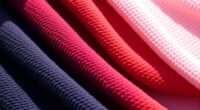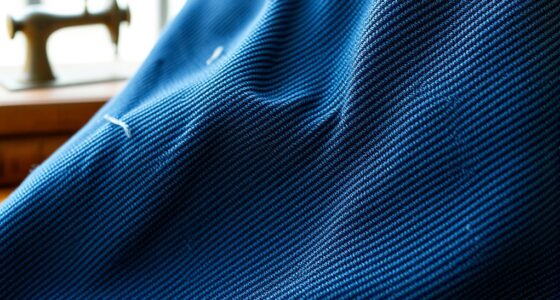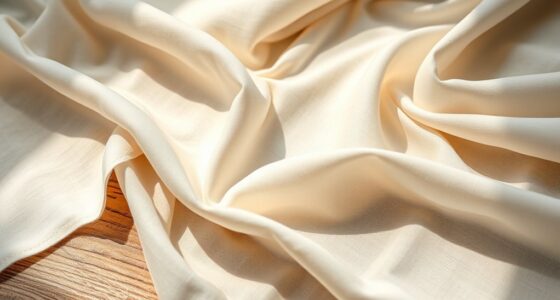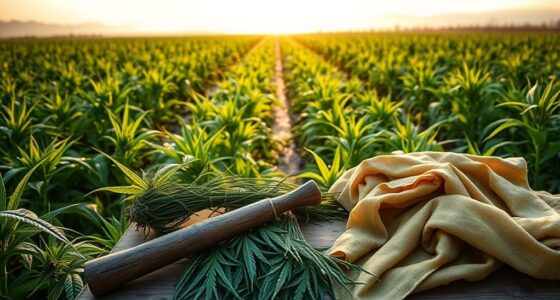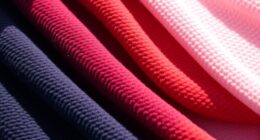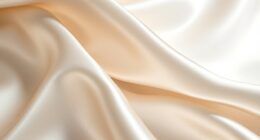Terry cloth is a soft, highly absorbent fabric made with loop pile construction that features thousands of tiny, looped yarns acting as micro-sponges to trap moisture. These loops increase the fabric’s surface area and moisture retention, making it ideal for towels, washcloths, and other items that need high absorbency. The unique design also provides softness and durability. Keep exploring to discover more about how this versatile fabric works and its many uses.
Key Takeaways
- Terry cloth features loop pile construction with tiny, looped yarns that enhance softness and moisture absorption.
- The loops trap and hold moisture effectively, increasing the fabric’s surface area and water retention.
- Known for its high absorbency, durability, and quick-drying properties, making it ideal for towels and washcloths.
- Its soft texture and plush feel make it suitable for clothing and household items requiring moisture management.
- Loop pile construction boosts fabric performance and longevity, ensuring long-lasting softness and functionality.

Have you ever wondered what makes terry cloth so soft and absorbent? The secret lies in its unique loop pile construction, which creates thousands of tiny, looped yarns that serve as tiny sponges. These loops increase the surface area of the fabric, allowing it to trap and hold moisture effectively. That’s why towels made from terry cloth feel plush against your skin and dry you quickly. The fabric’s absorbent properties are what set it apart from other textiles, making it an ideal choice for bath towels, washcloths, and even some clothing items. When you touch terry cloth, you notice not just its softness but also its capacity to soak up water, which is why it’s become a staple in households worldwide. Additionally, the loop pile construction enhances the fabric’s ability to retain moisture and improves its overall performance.
Frequently Asked Questions
Can Terry Cloth Be Used for Outdoor Furniture Covers?
You can use terry cloth for outdoor furniture covers, but keep in mind that its fabric durability and weather resistance are limited. While it’s soft and absorbent, terry cloth isn’t designed to withstand prolonged exposure to rain, sun, or wind. If you choose it, consider applying a protective waterproof coating or using it temporarily. For long-term outdoor use, look for more weather-resistant fabrics like canvas or polyester.
How Does Terry Cloth Compare to Microfiber in Absorbency?
When it comes to absorbency, you’ll find that terry cloth beats microfiber hands down. Microfiber may be durable, but terry cloth’s softness makes it a better choice for absorbing moisture quickly and comfortably. You get the best of both worlds—absorbency and plush feel—making it perfect for towels, while microfiber’s durability shines in other uses. Ultimately, it’s like comparing apples to oranges, each excelling in its own way.
Is Terry Cloth Suitable for Baby Clothing?
Yes, terry cloth is suitable for baby clothing because it offers excellent fabric softness and promotes baby comfort. Its looped pile construction makes it gentle against sensitive skin, providing a cozy feel. Plus, terry cloth’s absorbency helps keep your baby dry and comfortable. Just make sure the fabric is soft and free from harsh chemicals or dyes to maximize comfort and safety for your little one.
What Are the Best Washing Practices to Maintain Terry Cloth?
Did you know that proper washing extends terry cloth’s lifespan by up to 30%? To keep it soft and absorbent, use gentle fabric softening and wash in cold water. Avoid bleach and fabric softeners that can damage fibers. For drying, opt for low heat or air drying to prevent shrinkage and maintain its plush texture. These practices guarantee your terry cloth stays fresh and durable longer.
Can Terry Cloth Be Recycled or Eco-Friendly?
Terry cloth can be recycled, but recycling challenges exist due to its blend of fibers, making it less eco-friendly than other fabrics. To reduce environmental impact, you should look for eco-friendly alternatives like organic cotton or bamboo terry. You can also repurpose old towels into cleaning cloths or craft projects, which helps extend their life and minimizes waste, making your choices more sustainable.
Conclusion
Now that you know about terry cloth, you can think of it as the cozy backbone of your towels and more. Its looped structure is like a well-woven symphony, offering softness and absorbency in perfect harmony. Whether you’re wrapping yourself in a plush towel or exploring new fabric ideas, terry cloth invites you to enjoy its timeless versatility. Embrace this fabric’s gentle embrace, and let it be the foundation of your comfort.

